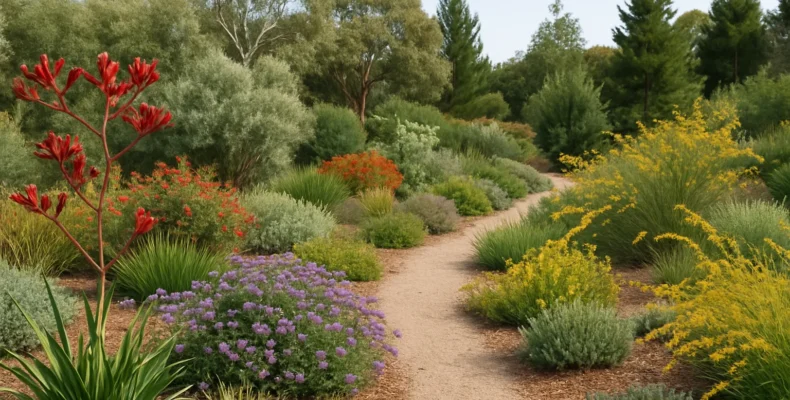Gardens bring peace and beauty to our lives. The colours, sounds, and fresh air help us feel calm and happy. Yet for many Australians, maintaining a vibrant garden can feel like an ongoing struggle. People find it difficult to enjoy their garden without spending too much time or money on upkeep.
The good news is that a garden can still look great without needing constant care or spending too much money.
This guide will show you how to plan, plant, and care for a native garden that fits into a busy lifestyle, without sacrificing charm or character. Let’s get into it.
Planning Your Native Garden
Planning a native plant garden in Australia starts with understanding your landscape, your goals, and the plants that bloom locally. Native trees should be a top choice in any sustainable garden. They are long-living, support local wildlife, and require little care once established.
Creating a garden that looks after itself results from a smart, thoughtful approach. Here’s how to design a space that’s sustainable, stunning, and surprisingly easy to maintain.
Step 1: Understand Your Local Environment
Get to know your soil and climate before buying the first pot. Australia is home to more than 24,000 native plant species, each adapted to its own patch of the land. What blooms in Perth may flop in Hobart. You can use the Australian climate guide for helpful reference on the weather.
Watch the sun like a curious cat. Take note of where sunlight hits and how it shifts through the day. Native plants will reward you if they’re placed in their preferred sunbathing spots.
Step 2: Set Clear Objectives
Have some clear objectives on what you want your garden to do. Is it a home for local birds, a peaceful space to sip tea, or your declaration of war against the water bill? Your purpose shapes the plant list.
Also, think beyond plants. Add simple features like stepping stones, shaded seats, or a pathway. These make your garden feel like a lived-in space, not a collection of leaves.
Step 3: Select Appropriate Native Plants
We recommend you stick to only local plants. Native species from your region are the easiest to care for and the most helpful to local wildlife. The Australian Native Plants Society has a handy plant finder to help match your postcode to the right plants.
Don’t let looks fool you. A cute little shrub today might become a garden-eating beast in five years. Always check the mature size and maintenance needs of each plant before bringing it home.
Step 4: Plan for Sustainability
Next up, you should group plants by thirst level. The reason for this is that wet-loving plants and dry-climate heroes don’t mix well. Keep watering simple by clustering similar types.
You can give your soil a lift now and then. A light dose of compost or aged organic matter will boost structure and nutrients. Healthy soil supports strong and adaptable plants without the need for constant feeding.
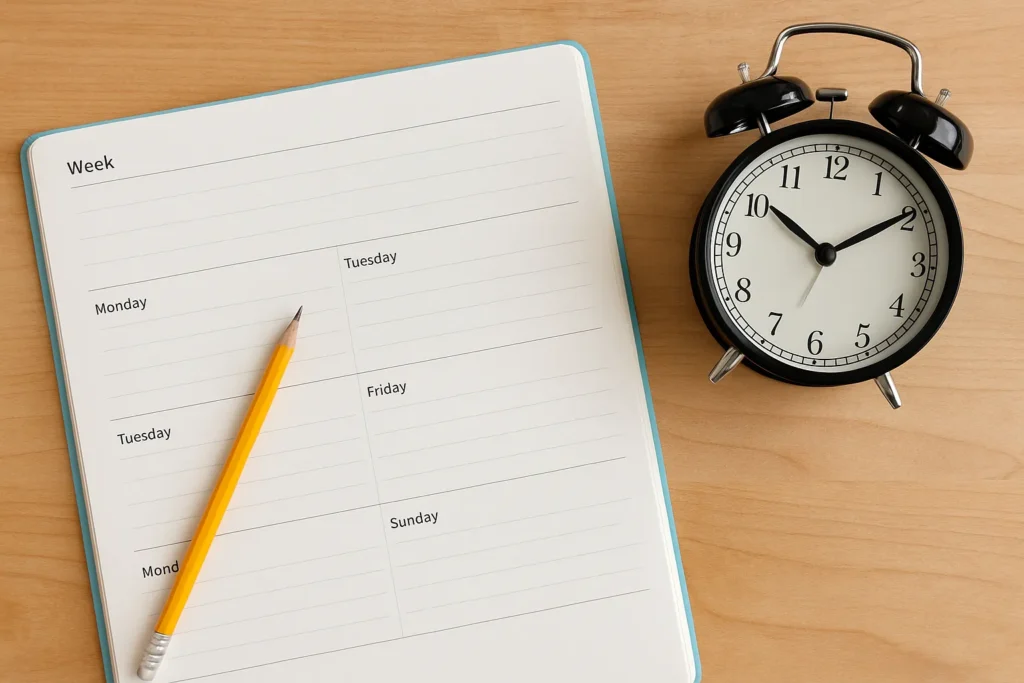
Step 5: Implement a Maintenance Schedule
A quick look around once a week can spot issues early. Yellowing leaves, chewed stems, or unexpected wilting are your garden’s way of waving a little red flag.
Care changes with the seasons. In autumn, it’s pruning and mulching. In spring, you might feed a few hungry growers. Native plants don’t need much, but they’ll grow with small seasonal routines.
We recommend marking tasks in your calendar. Just like birthdays or bin day, a quick reminder keeps things simple. You won’t need to hover over your plants, just check in from time to time.
Once your garden is ticking along, you can take it a step further. The next section explores how to shape it into a garden that takes care of itself.
Creating a Low-Maintenance Native Garden Design
Low-maintenance doesn’t mean no maintenance. But it should mean less mowing, less weeding, and more time with your feet up. The secret? A smart, simple garden design that works with nature, not against it.
If you’re starting fresh or refreshing a tired yard, choosing the right layout makes everything easier. You’ll spend less time fixing mistakes and more time enjoying your garden.
Start with Shape and Flow
Your garden should feel easy to move through, even barefoot. Shapes help guide your eye and your footsteps.
Wide curves, gentle borders, and clear paths make upkeep less fiddly. We suggest avoiding awkward angles, which easily become weed traps. So, try to keep it smooth and practical.
Layer Your Garden Like a Pro
Layer your garden with stacking plants by height. It helps to create a structure, boosts airflow, and makes watering more efficient. Tall trees or shrubs go at the back, medium-sized plants fill the middle, and low ground covers finish the front.
This setup keeps things tidy and functional. Plus, you’ll avoid accidentally stepping on new seedlings while chasing the hose.
Use Native Ground Covers
Exposed soil is like a welcome mat for weeds. Cover it, and you save yourself hours of future pulling.
Native ground covers act like living mulch. Kidney Weed, Creeping Boobialla, and Native Wisteria are good ground cover choices. They keep moisture in and pests out, all while adding texture and colour.
Mulch is More Than a Pretty Face
Mulch always looks neat. It holds water, insulates roots, and smothers weed seeds before they sprout. Use organic mulch like bark or straw, and top it up once or twice a year. That’s less work and healthier soil in one go.
Tip: Just don’t smother your plants. Think blanket, not mountain.
Rethink the Lawn
Lawns need mowing, watering, feeding, and whispering sweet nothings to stay green. In most native gardens, they’re optional at best. Swap the thirsty turf for gravel paths, stone steppers, or low-care native grasses. You’ll cut maintenance and gain style.
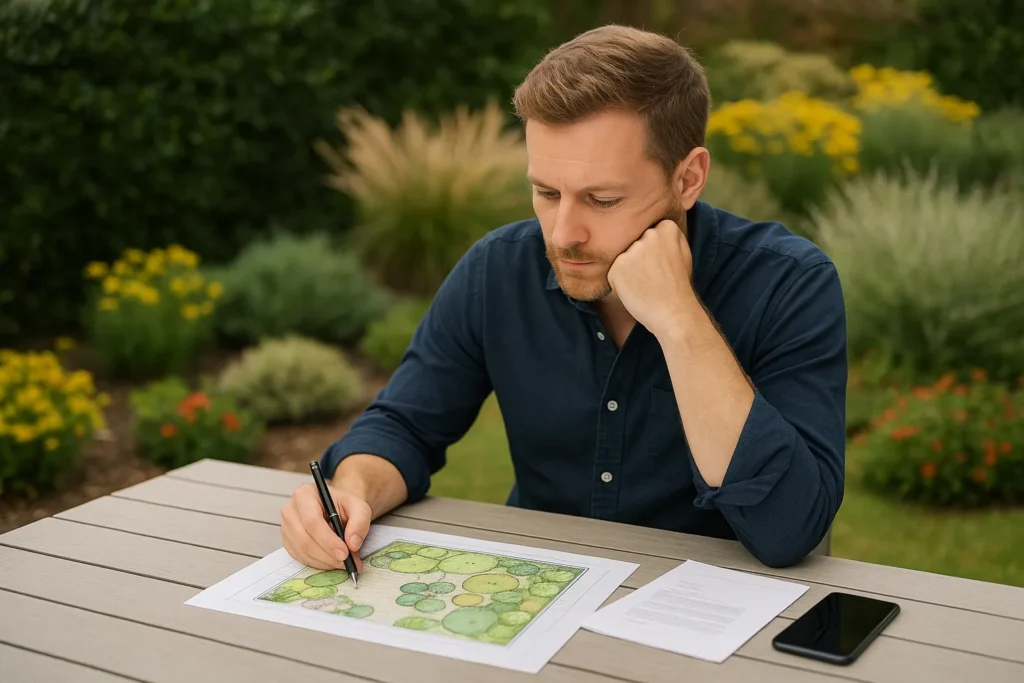
Add a Personal Touch
Your garden should reflect you. Add one feature that makes you smile every time you step outside. Maybe it’s a native flowering tree, a seat under the shade, or a birdbath tucked between shrubs. That “something special” makes your garden feel like home.
With the right layout and plant choice, you’ll enjoy a peaceful, low-maintenance garden that lasts for years. And to keep your garden alive, you should follow a native plant maintenance calendar.
Native Plant Maintenance Calendar
This Calendar is a seasonal guide that outlines the best times to care for native plants, including watering, pruning, and planting. Australian native plants are well-adapted to local conditions. So, they require less maintenance than exotic species. However, a seasonal care routine ensures they stay healthy and colourful all year.
Autumn (March–May)
Autumn is the perfect time to get new plants into the ground. The weather is cooler, but the soil still holds summer warmth, which encourages strong root growth. Here’s what to do in autumn for your garden:
Planting Season: This is the best time to plant most native species. The combination of warm soil and autumn rain helps young plants settle comfortably. You can grow any native plants of your desire.
Soil Preparation: We recommend you to enrich the soil with compost or aged manure before planting. Healthy soil leads to stronger, more drought-resistant plants.
Winter (June–August)
Winter may seem quiet, but it’s a good time to tidy up and prepare for spring. Native plants appreciate a little winter attention. Mark the dates on your calendar to prune and mulch regularly.
- Pruning: Cut back dead, damaged, or overly woody growth. Light pruning shapes your plants and encourages new shoots to come in spring.
- Mulching: You may top up mulch to keep the soil warm and reduce weed growth. Better aim for a 5–7 cm layer, but keep it clear of stems.
Spring (September–November)
Spring is a time of rapid growth, colour, and activity in the garden. This is when your plants shine, and a little support goes a long way.
Use Fertiliser: Use a low-phosphorus fertiliser suited to native plants early in spring. This promotes healthy foliage and flower growth without overfeeding.
Pest Watch: It would be wise to keep an eye out for aphids, caterpillars, or scale insects. Remove pests by hand or use natural sprays if required.
Summer (December–February)
Summer can be the toughest season for any garden, but native plants are built to handle the heat. A bit of well-timed care will help them get through the hottest months looking their best.
- Water Your Plants Now and Then: Established natives usually cope with less water, but extreme heat can still push their limits. Deep watering every two to three weeks is enough during dry spells. Do it early in the morning to reduce evaporation and avoid scorching leaves.
- Monitor Pests: You can expect trouble for the heat-stressed plants. Check leaves for chewing damage or sap-sucking pests. Use natural pest solutions early before they spread.
This seasonal maintenance calendar will help you keep your garden healthy, low-maintenance, and environmentally sustainable. You can also use sustainable technology in your garden for better results.
Integrating Sustainable Technology
Gardening shouldn’t feel like a full-time job with a watering can. That’s where sustainable gardening technology comes to the rescue. These smart, low-effort tools help your native plant garden use less water, less energy, and a lot less of your weekend.
With just a few clever additions, you can make your garden greener, easier to manage, and much more enjoyable.
Let’s look at a few ways you can make your garden smarter and easier to care for.
Rainwater Harvesting
Catching rainwater is the easiest and most natural way to keep your garden green. It reduces your need for tap water and gives your plants a chemical-free drink.
At our place, we installed a slimline tank beside the shed last autumn. After one storm, it filled right up. We now use that water for all the garden beds and haven’t touched the garden tap in months.
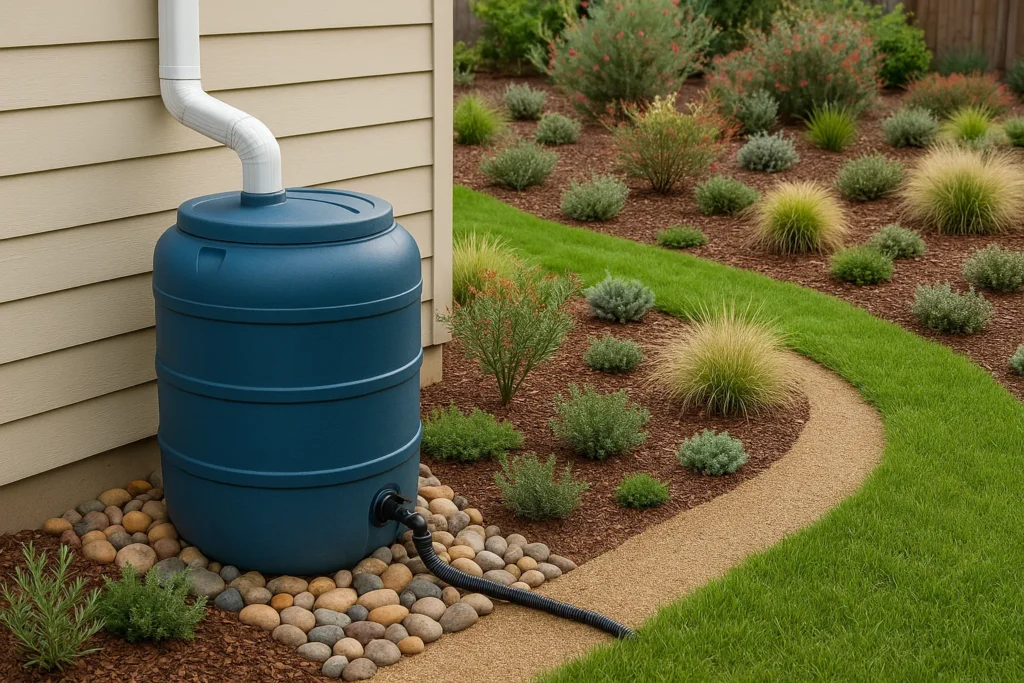
Solar-Powered Garden Lighting
Solar lights are simple, affordable, and surprisingly effective. A basic set of four solar path lights can cost as little as $20 to $40 AUD, depending on quality and design. These lights soak up sunlight during the day and switch on automatically at dusk. They’re perfect for lighting up paths, beds, or a cosy garden bench.
Greywater Recycling
Greywater is water from your washing machine, bathroom basin, or shower that’s reused to water the garden. It’s a clever way to save water without changing your routine.
To use greywater safely, choose gentle detergents without too many chemicals. Native plants are sensitive to additives, so go for low-phosphorus products.
Technology can do a lot, but sometimes a friendly chat at the local garden group does even more.
Community Gardening Support
Some of the best gardening moments happen when you’re not gardening alone. Community gardening support gives people a chance to connect, grow fresh food, and learn sustainable habits that stick.
Let’s see what the community gardening support can offer:
Engagement
Community gardens are becoming more common across suburbs and towns. According to The Australia Institute, about 45% of Australians grow some of their own food, whether at home or with others.
Sharing garden beds and swapping harvest tips makes growing feel more purposeful. There’s always someone to lend a hand or a spare punnet of cherry tomatoes.
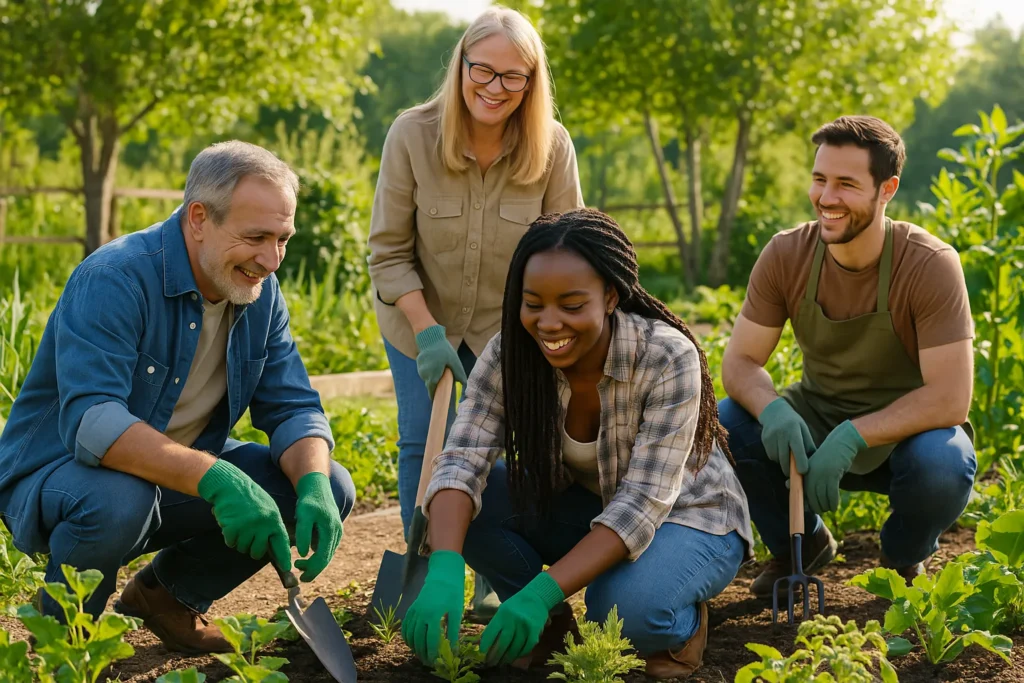
Physical and Mental Health Benefits
Gardening keeps you active without feeling like a chore. Digging, planting, and even gentle weeding all get the body moving.
At the same time, being outdoors with others can ease stress. The simple act of planting something together often leads to good chats and better moods.
Learning Platforms
Many gardens run weekend sessions or informal workshops. Groups like Cultivating Community help people learn everything from composting and crop rotation to native plant care. You don’t need any background in gardening.
Just show up, ask questions, and you’ll pick up useful tips from people who’ve been doing it for years.
Inclusive Programs
One of the best parts of community gardening is how welcoming it can be. These spaces bring together people from all walks of life. They can be young families, retirees, newcomers, and folks looking for something to be part of.
Environmental Impact
Community gardens reduce packaging waste, lower food miles, and encourage low-impact practices like composting and water saving. These gardens support a greener lifestyle without much fuss by growing close to home and sharing resources.
So, engaging in community gardening nurtures the environment and builds stronger, healthier communities. Now that we’ve covered the joys of community gardening, let’s chat about a few things not to do.
Common Mistakes to Avoid
Low-maintenance gardens can still run into trouble if a few basics are neglected. It’s easy to get excited and start planting everything at once, but taking a bit of time to plan will save you effort later on.
A major mistake is using native plants that don’t suit your location. Each region has its own climate, soil, and rainfall pattern. Try to choose species that naturally grow in your area. Here’s a list of plants you can choose if you’re from that area:
You can choose if you’re from that area:
- Sydney – Old Man Banksia, Mat Rush, Pink Spider Flower
- Melbourne – Native Fuchsia, Blue Flax Lily, Gold-dust Wattle
- Brisbane – Weeping Bottlebrush, Snake Vine, Snow-in-Summer
- Adelaide – Emu Bush, Sweet Bursaria, Common Everlasting
- Perth – Kangaroo Paw, Spreading Grevillea, Blue Lechenaultia
- Hobart – Mountain Pepper, Common Heath, Tussock Grass
- Canberra – Snow Gum, Native Rosemary, Woolly Grevillea
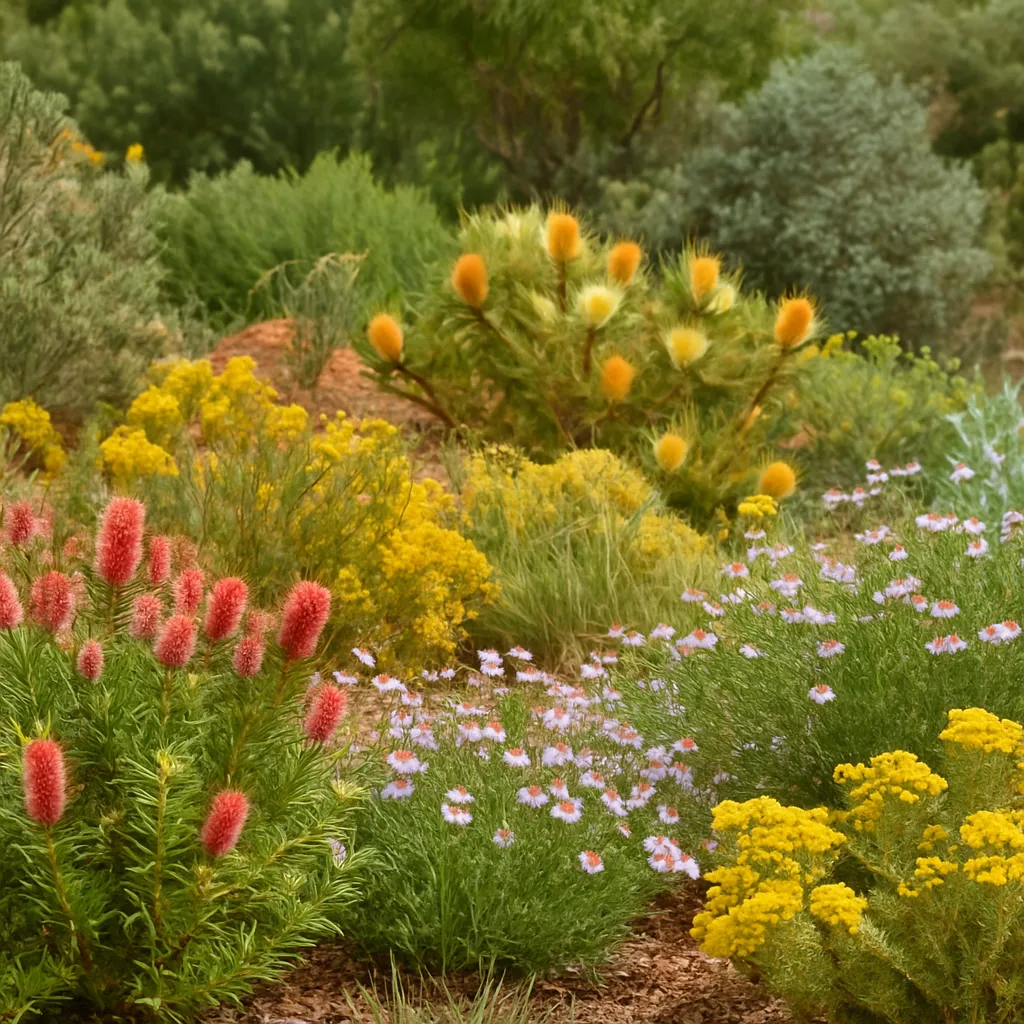
A quick visit to your local nursery or checking your council’s native plant guide can point you in the right direction.
Another common issue is overwatering. Before you reach for the hose, check the soil with your finger. If it feels damp, leave it be. Once established, most native plants are happy with deep watering every couple of weeks during dry spells.
Fertilising can also do more harm than good. Too much fertiliser can lead to fast, weak growth that flops over or attracts pests. Instead of chemical fertilisers, try using a handful of compost or a native-friendly blend if needed. Less really is more here.
Lastly, skipping seasonal care can lead to a garden that looks tired or overgrown. Even the toughest native plants need a quick prune or a health check once in a while. If it helps, set a reminder at the start of each season. You don’t need a full garden schedule. A few small check-ins will do the trick.
We’ve covered the essentials. Let’s wrap things up with a simple takeaway and next steps.
A Smarter Way to Garden with Nature
Gardening doesn’t have to be exhausting or expensive. Everything feels easier when you work with plants that suit your climate and soil. The garden grows better, and you spend more time enjoying it than fixing it.
We’ve walked through how to pick the right native plants, plan for the seasons, and make smart use of sustainable tools. You’ve learned how to avoid the usual pitfalls. Now it’s your turn to grow something special.
Begin with one corner of your yard. Try a few natives and add a path or a personal touch. Keep it simple and let nature do the heavy lifting.
If you’re looking for inspiration or practical outdoor living solutions, visit Bell Phillips Outdoor. You’ll get design ideas, sustainable tips, or beautiful ways to connect with your garden, basically everything you need to get started.
